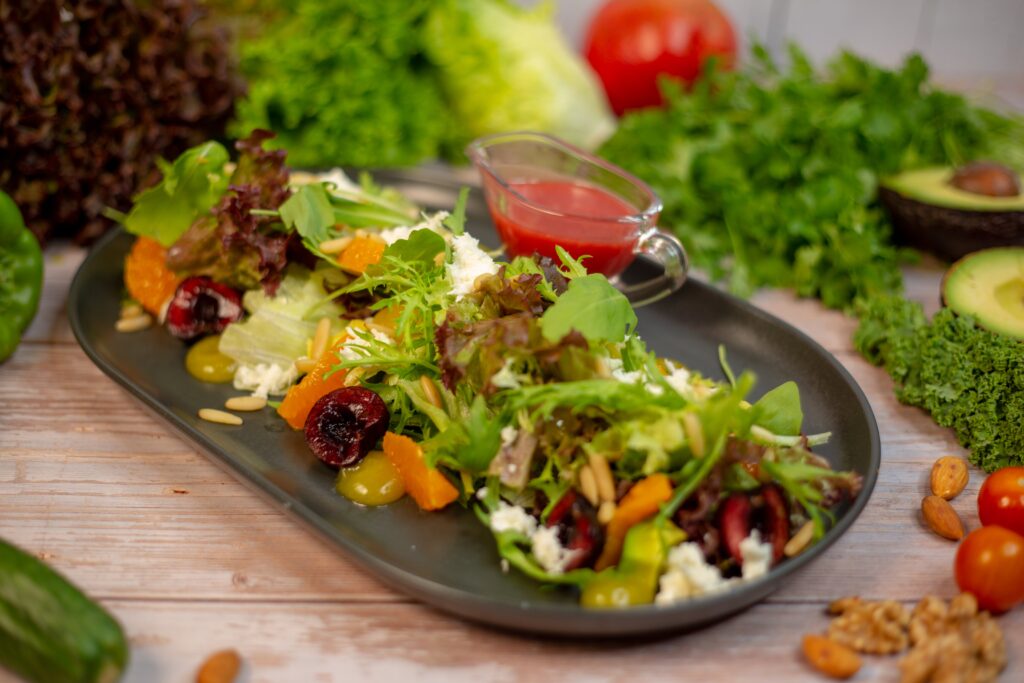5 Easy and Delicious Recipes Using Nutritious Fresh Produce
In an era when healthy eating is more than a trend—it’s a lifestyle—there’s never been a better time to embrace the natural goodness of fresh produce. Whether you’re a busy professional, a parent juggling family meals, or simply someone eager to boost energy and vitality, fresh fruits and vegetables offer an endless array of vitamins, minerals, antioxidants, and fiber. This article will guide you through five easy and delicious recipes that celebrate nutritious, seasonal produce while proving that healthy food can be both satisfying and exciting.
Over the next 4000 words, we’ll dive deep into the benefits of using fresh ingredients, offer step-by-step recipes, and share tips on selecting the best produce. Our goal is to equip you with practical tools and creative ideas so that you can transform simple ingredients into mouthwatering dishes that nourish your body and delight your taste buds.
Introduction: The Power of Fresh Produce
Fresh produce isn’t just about flavor—it’s about harnessing nature’s bounty to create meals that support a vibrant, healthy life. Fruits and vegetables are rich in essential nutrients that help fight inflammation, boost immune function, and promote overall wellness. They come in a variety of colors, each representing different antioxidants and phytonutrients that protect your body against disease.
Eating produce at its peak freshness ensures that you enjoy the highest levels of vitamins and minerals available. Seasonal produce is not only tastier and more affordable but also tends to have a lower environmental footprint compared to out-of-season alternatives. By incorporating fresh produce into your daily meals, you’re investing in long-term health while also treating your palate to a spectrum of delightful flavors and textures.
In this guide, we’ll explore five recipes that make the most of fresh, nutritious ingredients. Each recipe is designed to be easy enough for beginners yet versatile enough to inspire even the most experienced home cooks. From refreshing salads to hearty bowls and vibrant smoothie bowls, these dishes will help you rediscover the joy of eating well.
Benefits of Nutritious Fresh Produce
Before we get into the recipes, it’s important to understand why fresh produce is so beneficial for your health. Here are some key reasons:
1. Nutrient Density
Fresh fruits and vegetables pack a powerful nutritional punch. They provide vitamins (like vitamin C, A, and K), minerals (such as potassium and magnesium), and antioxidants that help neutralize harmful free radicals. By choosing nutrient-dense foods, you get more beneficial compounds per calorie, helping your body function at its best without excess energy intake.
2. Fiber for Digestive Health
Fiber is essential for maintaining healthy digestion, regulating blood sugar, and keeping you feeling full. Most fresh produce is high in fiber, which not only aids in digestion but also supports a healthy gut microbiome—a crucial factor in overall immunity and well-being.
3. Hydration and Detoxification
Many fruits and vegetables have a high water content, which contributes to hydration and helps flush out toxins. Eating water-rich foods can also aid in maintaining a healthy complexion and keeping your energy levels steady throughout the day.
4. Antioxidant and Anti-Inflammatory Properties
The vivid colors of fresh produce are often a sign of high antioxidant content. Antioxidants protect your cells from damage and reduce inflammation—a root cause of many chronic illnesses. Regular consumption of fresh produce has been linked to a lower risk of heart disease, certain cancers, and age-related cognitive decline.
5. Versatility in the Kitchen
Fresh produce can be enjoyed raw, steamed, roasted, grilled, or blended into smoothies. This versatility makes it easy to incorporate into any meal or snack, ensuring that you can enjoy a varied diet without sacrificing taste or convenience.
With these benefits in mind, let’s move on to the recipes that will help you make the most of nutritious fresh produce.
Recipe 1: Citrus Garden Salad
This vibrant and refreshing salad is a celebration of crisp greens, juicy citrus, and a medley of fresh vegetables. It’s perfect as a starter, a light lunch, or a side dish for dinner.
Ingredients
- Greens:
• 4 cups mixed salad greens (such as arugula, spinach, and baby kale)
• 1 cup baby spinach leaves - Citrus:
• 1 large orange, segmented (or 2 smaller oranges)
• 1 grapefruit, segmented - Vegetables:
• 1 medium cucumber, thinly sliced
• 1 cup cherry tomatoes, halved
• 1/2 red onion, thinly sliced
• 1/2 cup radishes, thinly sliced - Extras:
• 1/4 cup toasted walnuts or pecans (optional, for crunch)
• 1/4 cup crumbled feta cheese (optional) - Citrus Vinaigrette:
• Juice of 1 lemon
• Juice of 1 orange (reserve extra citrus from the salad if available)
• 3 tablespoons extra-virgin olive oil
• 1 teaspoon honey or maple syrup
• Salt and pepper to taste
• 1 teaspoon Dijon mustard (optional)
Instructions
-
Prepare the Greens:
Rinse all greens thoroughly under cold water and pat dry with a clean towel. Tear or chop the greens into bite-sized pieces and place them in a large salad bowl. -
Segment the Citrus:
Use a sharp knife to cut away the peel and white pith of the orange and grapefruit. Over a bowl, carefully segment the fruit by cutting between the membranes. Reserve any extra citrus juice that drips out. -
Chop the Vegetables:
Thinly slice the cucumber, red onion, and radishes. Halve the cherry tomatoes. Add all the vegetables to the bowl with the greens. -
Make the Dressing:
In a small bowl, whisk together the lemon juice, reserved orange juice, olive oil, honey, Dijon mustard (if using), salt, and pepper until emulsified. -
Assemble the Salad:
Gently toss the mixed greens and vegetables with the citrus segments. Drizzle the dressing over the salad and toss again until everything is evenly coated. -
Finish and Serve:
Top the salad with toasted nuts and crumbled feta cheese. Serve immediately to enjoy the crisp textures and refreshing flavors.
Nutritional Benefits
- Vitamins & Minerals: Citrus fruits provide a hefty dose of vitamin C, while greens offer vitamins A, K, and folate.
- Antioxidants: The combination of colorful produce supplies a wide range of antioxidants that fight inflammation.
- Fiber: A variety of vegetables ensures plenty of fiber, aiding digestion and promoting satiety.
Tips & Variations
- Seasonal Swap: In winter, try adding slices of pomegranate seeds or mandarins for a seasonal twist.
- Protein Boost: Top with grilled chicken or tofu slices for a heartier meal.
- Herbs: Fresh mint or basil can elevate the flavor profile of the salad even further.
Recipe 2: Roasted Veggie & Quinoa Bowl
Hearty, comforting, and packed with nutrition, this roasted veggie and quinoa bowl is an ideal meal for lunch or dinner. The dish combines warm, roasted vegetables with protein-rich quinoa and a tangy lemon-tahini dressing.
Ingredients
- Vegetables:
• 1 large sweet potato, peeled and cubed
• 1 red bell pepper, cut into chunks
• 1 zucchini, sliced into rounds
• 1 cup broccoli florets
• 1 red onion, cut into wedges - Quinoa:
• 1 cup quinoa, rinsed thoroughly
• 2 cups water or low-sodium vegetable broth - Olive Oil & Seasonings:
• 3 tablespoons extra-virgin olive oil
• 1 teaspoon salt
• 1/2 teaspoon black pepper
• 1 teaspoon smoked paprika
• 1/2 teaspoon garlic powder - Lemon-Tahini Dressing:
• 3 tablespoons tahini
• Juice of 1 lemon
• 1-2 tablespoons water (to thin, as needed)
• 1 small garlic clove, minced
• Salt and pepper to taste - Garnishes:
• Fresh parsley, chopped
• A sprinkle of sesame seeds
Instructions
-
Preheat Oven:
Preheat your oven to 400°F (200°C). Line a large baking sheet with parchment paper for easy cleanup. -
Prepare the Vegetables:
Place the sweet potato, red bell pepper, zucchini, broccoli, and red onion on the baking sheet. Drizzle with olive oil and sprinkle salt, pepper, smoked paprika, and garlic powder over the vegetables. Toss well to coat evenly. -
Roast the Vegetables:
Roast in the preheated oven for 25–30 minutes, stirring halfway through, until the vegetables are tender and slightly caramelized on the edges. -
Cook the Quinoa:
While the vegetables are roasting, combine the rinsed quinoa and water (or broth) in a medium saucepan. Bring to a boil, then reduce heat to low, cover, and simmer for about 15 minutes until the quinoa is fluffy and all liquid is absorbed. Remove from heat and let it sit covered for 5 minutes, then fluff with a fork. -
Prepare the Dressing:
In a small bowl, whisk together the tahini, lemon juice, minced garlic, salt, and pepper. Add water gradually until you reach a pourable consistency. -
Assemble the Bowl:
In serving bowls, layer the cooked quinoa as a base. Top with a generous helping of roasted vegetables. Drizzle with the lemon-tahini dressing. -
Garnish & Serve:
Sprinkle with chopped parsley and sesame seeds. Enjoy warm or at room temperature for a satisfying, nutrient-packed meal.
Nutritional Benefits
- Complex Carbs & Protein: Quinoa is a complete protein and a great source of fiber and minerals.
- Vitamins & Antioxidants: A rainbow of roasted vegetables provides a range of antioxidants, vitamin C, and beta-carotene.
- Healthy Fats: Olive oil and tahini supply monounsaturated fats that support heart health.
Tips & Variations
- Add Greens: Stir in a handful of baby spinach or kale just before serving for extra greens.
- Protein Addition: Toss in chickpeas or black beans for additional protein and fiber.
- Make-Ahead: This bowl can be made ahead and enjoyed cold as a refreshing salad on warmer days.
Recipe 3: Zucchini Noodles with Fresh Tomato Basil Sauce
For a light, gluten-free alternative to traditional pasta, zucchini noodles—often called “zoodles”—are a brilliant choice. Paired with a vibrant tomato basil sauce, this dish is both refreshing and satisfying.
Ingredients
- Zoodles:
• 4 medium zucchinis
• A pinch of salt - Tomato Basil Sauce:
• 4 large ripe tomatoes, roughly chopped (or a 14-ounce can of crushed tomatoes)
• 3 garlic cloves, minced
• 1 small onion, finely chopped
• 2 tablespoons olive oil
• A handful of fresh basil leaves, torn
• 1 teaspoon dried oregano
• Salt and pepper to taste - Optional Toppings:
• Grated Parmesan or a vegan alternative
• A drizzle of extra-virgin olive oil
Instructions
-
Make Zoodles:
Wash the zucchinis thoroughly. Using a spiralizer or a vegetable peeler, create long, noodle-like strands. Place the zoodles in a colander, sprinkle with a pinch of salt, and let them sit for 10 minutes. This draws out excess water; then gently pat them dry with paper towels. -
Prepare the Sauce:
In a large skillet, heat olive oil over medium heat. Add the chopped onion and garlic, sautéing until translucent and fragrant. Add the chopped tomatoes (or crushed tomatoes), dried oregano, salt, and pepper. Simmer the sauce for 10–15 minutes, stirring occasionally until it thickens slightly. -
Incorporate Fresh Basil:
Just before removing the sauce from the heat, stir in the fresh basil leaves. Adjust seasoning as needed. -
Combine Zoodles and Sauce:
Add the prepared zoodles to the skillet with the tomato basil sauce. Toss gently to coat the noodles without overcooking. Allow the flavors to meld together for 2–3 minutes on low heat; the zoodles should remain slightly firm. -
Serve & Garnish:
Plate the zoodles in bowls and top with a light sprinkle of grated Parmesan or vegan cheese. Finish with a drizzle of extra-virgin olive oil and a few extra basil leaves for garnish.
Nutritional Benefits
- Low-Carb Alternative: Zucchini noodles are low in calories and carbohydrates, making them a perfect substitute for traditional pasta.
- Vitamins & Lycopene: Fresh tomatoes are an excellent source of vitamin C and lycopene, an antioxidant linked to reduced risk of heart disease.
- Digestive Health: The fiber in zucchini and tomatoes aids digestion and supports a healthy gut.
Tips & Variations
- Extra Protein: For a heartier meal, add grilled shrimp or sautéed chicken strips to the zoodles.
- Raw Option: Enjoy the sauce over raw zoodles for a crisp, refreshing texture in warm weather.
- Creamy Twist: Blend in a few tablespoons of cashew cream for a rich, dairy-free version of the sauce.

Recipe 4: Stuffed Bell Peppers with Brown Rice & Spinach
Colorful, flavorful, and full of nutritious ingredients, these stuffed bell peppers make a delightful main course. Packed with brown rice, fresh spinach, tomatoes, and herbs, they’re baked to perfection and served as a complete meal.
Ingredients
- Bell Peppers:
• 4 large bell peppers (choose a mix of red, yellow, and orange for color) - Filling:
• 1 cup cooked brown rice
• 2 cups fresh spinach, roughly chopped
• 1 medium tomato, diced
• 1 small onion, finely chopped
• 2 garlic cloves, minced
• 1/2 cup black beans (optional for extra protein), rinsed and drained
• 1 teaspoon ground cumin
• 1/2 teaspoon smoked paprika
• Salt and pepper to taste
• 1/4 cup shredded cheese (cheddar or mozzarella, or a vegan alternative) - Garnish:
• Fresh cilantro or parsley, chopped
• A squeeze of lime juice
Instructions
-
Preheat Oven:
Preheat your oven to 375°F (190°C). Lightly grease a baking dish large enough to hold the stuffed peppers. -
Prepare the Bell Peppers:
Slice off the tops of the bell peppers and remove the seeds and membranes. If necessary, trim the bottoms slightly so they stand upright. Set aside. -
Sauté the Aromatics:
In a large skillet, heat a tablespoon of olive oil over medium heat. Add the chopped onion and garlic, sautéing until softened. Stir in the diced tomato and cook for an additional 3 minutes until the tomato begins to break down. -
Make the Filling:
Add the chopped spinach to the skillet and cook until wilted. Stir in the cooked brown rice, black beans (if using), ground cumin, smoked paprika, salt, and pepper. Mix thoroughly until all ingredients are well combined. Remove the skillet from the heat and fold in half of the shredded cheese. -
Stuff the Peppers:
Spoon the rice and spinach mixture evenly into each bell pepper. Place the stuffed peppers upright in the prepared baking dish. Top each pepper with the remaining cheese. -
Bake:
Cover the dish with foil and bake in the preheated oven for 30 minutes. Remove the foil and bake for an additional 10 minutes, allowing the cheese to melt and the peppers to become tender. -
Garnish & Serve:
Remove the peppers from the oven and garnish with chopped cilantro or parsley and a squeeze of lime juice. Serve warm as a hearty, wholesome meal.
Nutritional Benefits
- Whole Grains: Brown rice adds fiber and essential B vitamins.
- Leafy Greens: Spinach provides iron, calcium, and a wealth of antioxidants.
- Legumes: Black beans (if included) offer protein and additional fiber.
Tips & Variations
- Meat Lovers: Add lean ground turkey or chicken to the filling for a non-vegetarian option.
- Vegan Version: Use a dairy-free cheese substitute or simply omit the cheese altogether.
- Extra Veggies: Incorporate diced zucchini or corn into the filling for added texture and flavor.
Recipe 5: Fresh Fruit & Nut Smoothie Bowl
Start your day with a burst of energy by blending up a vibrant smoothie bowl. This recipe combines fresh fruits, nutrient-dense nuts, and a touch of seeds for extra crunch. It’s as visually appealing as it is delicious and is perfect for breakfast or a revitalizing snack.
Ingredients
- Smoothie Base:
• 1 frozen banana
• 1 cup frozen mixed berries (blueberries, strawberries, raspberries)
• 1/2 cup fresh spinach (optional, for a nutrient boost)
• 1/2 cup almond milk (or your favorite milk alternative)
• 1 tablespoon almond butter (optional, for extra creaminess and protein) - Toppings:
• 1/4 cup granola or rolled oats
• 1 tablespoon chia seeds
• 1/4 cup fresh fruit (sliced kiwi, berries, or mango)
• A handful of chopped nuts (almonds, walnuts, or cashews)
• A drizzle of honey or maple syrup (optional, for extra sweetness) - Optional Extras:
• A sprinkle of unsweetened coconut flakes
• A dash of cinnamon for warmth
Instructions
-
Blend the Base:
In a high-speed blender, combine the frozen banana, frozen mixed berries, fresh spinach (if using), almond milk, and almond butter. Blend until smooth and creamy. The consistency should be thick enough to eat with a spoon; add more almond milk if needed, but aim to keep it dense. -
Pour & Decorate:
Transfer the smoothie into a bowl. Arrange the toppings artfully over the surface. Begin with a layer of granola or rolled oats, then add chia seeds, fresh fruit slices, and chopped nuts. Drizzle a small amount of honey or maple syrup over the top if you prefer extra sweetness. -
Serve Immediately:
Enjoy your smoothie bowl with a spoon. The combination of creamy blended fruit and crunchy toppings makes for a satisfying texture and a refreshing start to your day.
Nutritional Benefits
- Antioxidants & Vitamins: Berries are high in antioxidants, while fruits like banana and kiwi offer vitamin C and potassium.
- Healthy Fats & Protein: Nuts and almond butter provide heart-healthy fats and protein, supporting sustained energy release.
- Fiber: Chia seeds and granola contribute to a fiber-rich meal, aiding digestion and helping you feel full longer.
Tips & Variations
- Make It Green: If you enjoy a green twist, add extra spinach or kale to the base for additional vitamins without compromising taste.
- Boost the Protein: Stir in a scoop of your favorite protein powder for an extra protein boost—ideal for post-workout recovery.
- Seasonal Fruits: Adapt the toppings to whatever fruits are in season to keep your smoothie bowl fresh and exciting.
Tips for Selecting and Storing Nutritious Fresh Produce
Choosing the best ingredients is key to making these recipes shine. Here are some quick tips on selecting and storing fresh produce:
1. Shop Seasonally
- Benefits: Seasonal produce is often fresher, more flavorful, and more affordable.
- Tip: Visit local farmers’ markets when possible to support your community and enjoy produce at its peak.
2. Look for Vibrant Colors
- Benefits: Bright, colorful fruits and vegetables tend to be richer in antioxidants and phytonutrients.
- Tip: Choose produce with deep, rich colors—whether it’s the deep red of tomatoes or the vibrant green of spinach.
3. Store Properly
- Benefits: Proper storage extends the shelf life and nutritional value of fresh produce.
- Tip: Keep leafy greens in airtight containers or plastic bags with a paper towel to absorb excess moisture. Store fruits and vegetables separately if possible, as some fruits emit ethylene gas that can speed up spoilage.
4. Wash Thoroughly
- Benefits: Washing removes dirt, bacteria, and pesticides.
- Tip: Rinse produce under cold water before use; for items with firmer skins, use a produce brush to scrub off any residues.
Bringing It All Together
The five recipes presented in this guide—Citrus Garden Salad, Roasted Veggie & Quinoa Bowl, Zucchini Noodles with Tomato Basil Sauce, Stuffed Bell Peppers with Brown Rice & Spinach, and Fresh Fruit & Nut Smoothie Bowl—demonstrate how simple it can be to create delicious, balanced meals using nutritious fresh produce. Each recipe is designed to be flexible, allowing you to adapt ingredients based on what’s available and what suits your taste.
Embracing fresh produce in your daily cooking routine not only elevates the nutritional value of your meals but also sparks creativity in the kitchen. The process of selecting, preparing, and enjoying fresh ingredients can be both therapeutic and energizing. From the crisp crunch of fresh salad greens to the comforting warmth of roasted vegetables, every bite is an opportunity to nourish your body and delight your senses.
Healthy eating doesn’t have to be complicated. With a few basic techniques and a willingness to experiment, you can transform simple produce into culinary masterpieces that are as good for your health as they are for your soul. These recipes prove that when you use fresh, wholesome ingredients, the possibilities are endless.
Conclusion
In today’s fast-paced world, finding time to prepare healthy, balanced meals can be a challenge. However, by focusing on nutritious fresh produce, you can create simple, delicious recipes that fuel your body and support long-term well-being. Whether you’re whipping up a colorful Citrus Garden Salad, a hearty Roasted Veggie & Quinoa Bowl, light and refreshing Zucchini Noodles with Tomato Basil Sauce, savory Stuffed Bell Peppers, or a revitalizing Fresh Fruit & Nut Smoothie Bowl, you’re making a commitment to health that begins on your plate.
These five recipes are just a starting point. Experiment with different ingredients, vary your spices, and adapt the dishes to your personal taste and nutritional needs. With each meal, you’re not only enjoying a delicious creation—you’re investing in your future health. Fresh produce, with its abundance of vitamins, minerals, and antioxidants, is nature’s gift to those who seek a balanced, vibrant life.
So, go ahead—explore the colorful world of fresh produce, try these recipes, and discover the joy of cooking meals that are both easy and delicious. Your body and taste buds will thank you.


